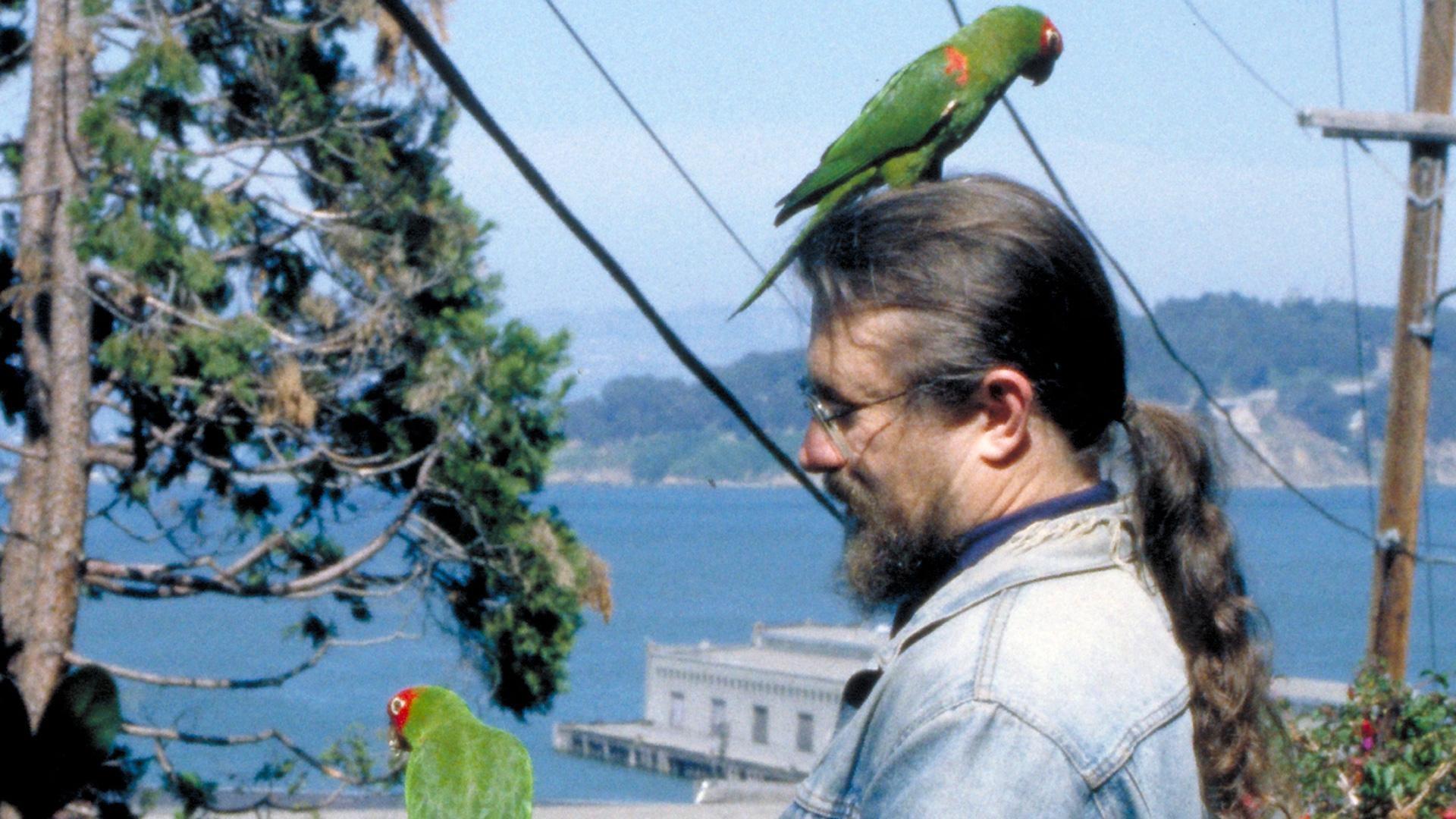By Chlotrudis Independent Film Society
Rating: 3.25
Director: Judy Irving

Country: united_states
Year: 2005
Running time: 83
IMDB: http://www.imdb.com/title/tt0411674/combined
Bruce says: “Mark Bittner arrived in San Francisco a couple of decades ago hoping to make it big in the music business. He wrote his own songs and performed in local watering holes. Somewhere along the line Bittner realized that his dream would not be fulfilled and he dropped out, retreating to a vintage 1880 gardener’s cottage on Telegraph Hill. He was more or less a squatter.
“Noticing that there were some colorful, green birds flying around, Mark put out a bowl on his deck and soon four cherry-headed conures were regular visitors. From a group of four emerged a flock of forty-five parrots many of which were born to parents from the original cluster and some of which joined the group probably after escaping from cages in homes, pet stores or cargo ships.
“A modern age St. Francis, Bittner began tending to the injured and the ill, naming them as each became involved in his life. Each of the forty-five birds Bittner has named has distinct features or a unique personality. We get to meet some of them. Picasso received a bloody eye in a fight; Sofie fell out of a tree; Mingus dances so music and prefers to stay indoors; Connor (the only blue-headed conure in the flock) is quiet and cranky because he doesn’t have a mate. The parrots fascinated Bittner and he began to document their habits and idiosyncrasies in a journal. Totally changing the course of his life, Bittner began writing articles about his experience and taking photos of the birds. To his surprise he became somewhat of a celebrity.
“During the filming of THE WILD PARROTS OF TELEGRAPH HILL, Bittner’s world comes tumbling down when Tom and Denise, the owners of the cottage, evict him because they are going to fix the structure which has become damaged over the years. Bittner has to find Mingus a home. As he leaves the world of wild parrots behind he ruminates on life’s vicissitudes. Upon leaving the theater, I couldn’t help feeling how better the world would be if there were more men like Mark Bittner.
“Irving does a decent job filming her subjects; she seems as enamored by the wild birds as Bittner. The film is focused albeit a bit confined since it does not stray far beyond Bittner’s domain. 3.5 cats”
Janet says: “Standing outside the Embassy Theater yesterday to choose my movie on the basis of the posters, I almost skipped this one because of the lousy typeface (Tekton upper and lower case), which really said ‘cheesy’ to me. The title typeface in a movie’s ads and posters can be a good indicator of the sensibility you’re dealing with. (3D bronze lettering is an excellent signal to beware—as is having the first and last letters of a word be bigger than the others. That, and not the news stories or the reviews,
is what kept me away from THE PASSION OF THE CHRIST.)
“In this case I’m glad I overcame my hesitation, because this little film was worth seeing. (I have to assume that they had no money to spend on a graphic designer.) As Bruce has already explained, the film is about Mark Bittner, who feeds and sustains a flock of parrots in a breathtakingly beautiful neighborhood of San Francisco. Bittner is described as an eccentric, but that’s all relative—he wouldn’t stand out at a meeting of the Chlotrudis nominating committee. He is a bit of a lost soul, and his enthusiasm for these birds is quixotic; he doesn’t have an ornithological background, and his efforts aren’t taken seriously by ornithologists or conservationists because the birds are essentially escaped pets rather than indigenous creatures. So in a way this isn’t even a nature film.’
“The film is a wonderful comment on how people interact emotionally with animals and pets. Mark creates a running narrative about the birds’ emotional lives—how they feel about one another and about him. To what extent are his observations accurate, and to what extent are they projections of human emotions? When we say a pet ‘loves’ us, is there real love there, or are they just coming back for the food? Was Mark necessary to these critters, or were the critters necessary to Mark? In a certain mood, you could come out of the theater questioning the entire emotional construct of your life—THE MATRIX with feathers.
“The director, Judy Irving, does a beautiful job with the nature footage and presents a balanced view of the community’s reactions to Mark. Aside from one sequence using Peruvian music, the soundtrack could have been a little better. I found the original guitar music bland and soporific, although there may be a traditional Spanish reference there that I’m not catching because I’m an Easterner. Although I generally go for more edge, wit, and sharpness in my film choices, I recommend this one because of the questions it raises.
“3 cats—make that 4 if you love animals”
